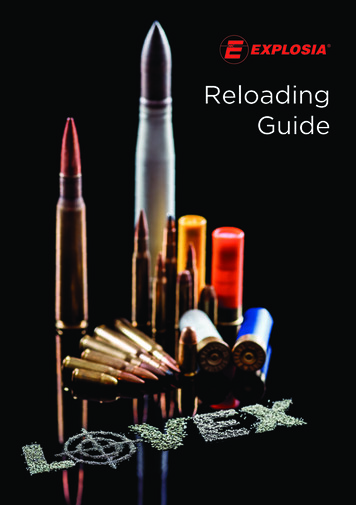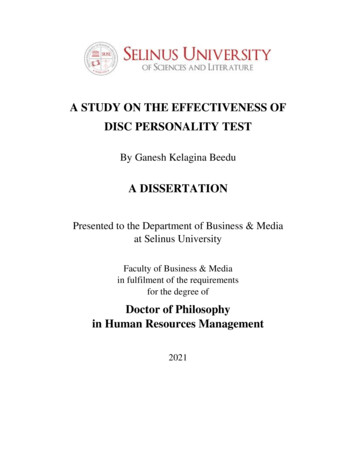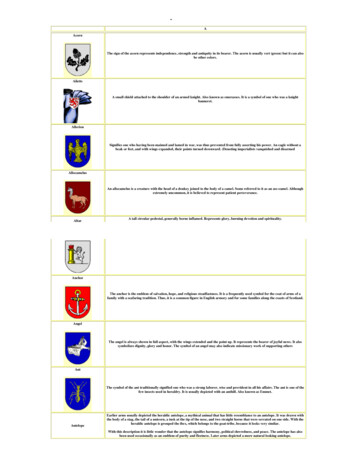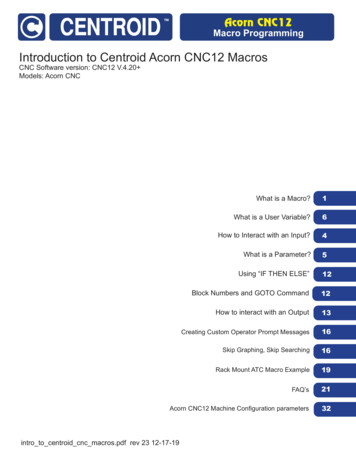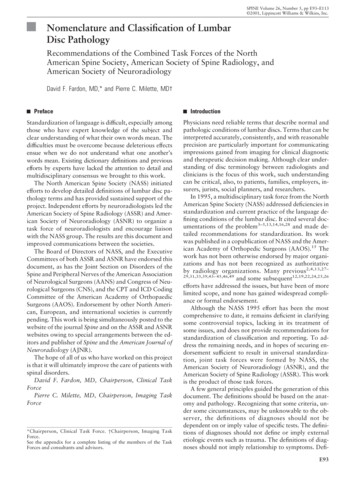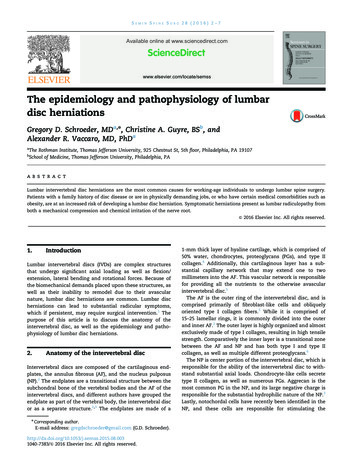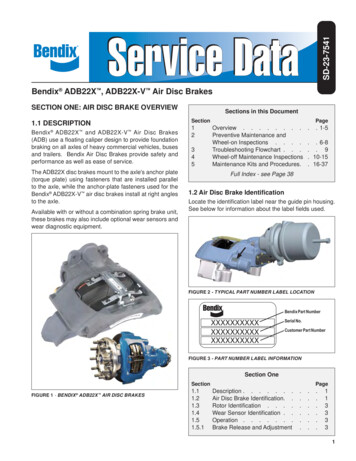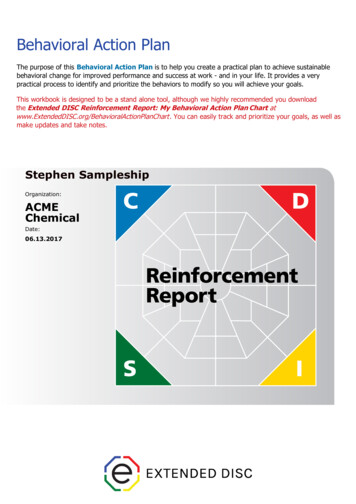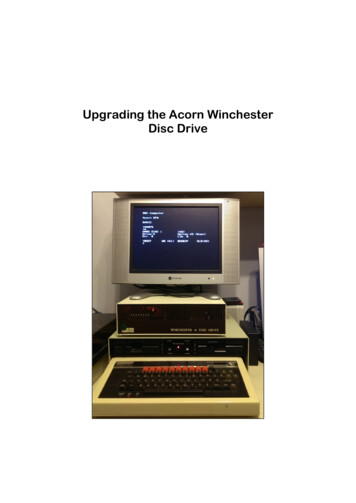
Transcription
Upgrading the Acorn WinchesterDisc Drive
flaxcottage.comFebruary 2020INTRODUCTIONThe Acorn Winchester hard drive was introduced in 1984 with an initial capacity of 10.3Mb. Later versionswere produced with larger capacities.In this example the hard disc was a Seagate ST-412 full height, 5" hard drive with a ST-506 controller boardand an intermediate interface board to the Acorn 1MHz bus. The unit was self-powered from an internalpower supply connected to the 240v AC mains.When the Winchester arrived at the Flax Cottage Educational Archive and tested, it reported that it had anerror, reporting error code 1C at 0/0000. This indicated that the drive needed re-formatting or that thehard drive needed to be replaced.Reformatting was attempted but the formatting halted at the same point each time. It was clear that thedisc could not be resuscitated. Although it would be possible to replace the hard drive it was felt that, sincesuch a replacement would be very old, of limited capacity, very expensive and likely to fail, a more modernstorage system should be built into the Winchester case, keeping all the original electronics in situ.Space inside the Winchester casing was limited and this is shown in figure (i) below.Figure (i)The large hard drive is at the bottom of the picture. Above that is the interface board linking the 1MHz busto the ST-506 interface board underneath. The switch mode power supply is at the top right. At the bottomright is the cooling fan, a noisy 240v device. The internal 1MHz bus cable is the grey ribbon cable at the topright.All the power connectors and the 1MHz ribbon cable have been disconnected in preparation for upgrading.Page 1
flaxcottage.comFebruary 2020SPECIFICATIONConnectors:250v AC fused at 1A Kettle Plug. The equipment must be earthed34-way cable to connect to 1MHz bus of host computer (BBC micro or Master)Storage:Compact Flash card IDE hard disc drive emulation2Gb CF card formatted to contain two 500Mb ADFS partitions (these appear asADFS drives 0 and 1Indicators:The front LED shows drive activity.Page 2
flaxcottage.comFebruary 2020CONSTRUCTIONSince the original electronics were to be left in situ, there was no space to fit an IDE hard drive so aCompact Flash card was to be used to emulate the hard drive. A 2Gb card was available and, afterformatting, this could support two 500Mb hard drive analogues.In order to link the Compact Flash card to the 1MHz bus two interface cards would be required. Firstly the1MHz bus to IDE interface would need to be sourced. Luckily Retroclinic was able to provide such aninterface. In actual fact this was a prototype IDE interface built on a DataCentre PCB, one of only two inexistence. The second interface to link the CF card to the 40-pin IDE connector on the Retroclinic interfacewas luckily to hand.Figure (ii)Figure (ii) shows the interface used and the Compact Flash card already in place. JP1 on the right of thecircuit board was later moved to position 2-3 so that the board would be powered by the Retroclinicinterface rather than needing a separate power feed.Page 3
flaxcottage.comFebruary 2020Figure (iii)Figure (iii) above shows the Retroclinic IDE interface. This was made from an Issue 2 DataCentre andincluded only the components necessary to construct the IDE interface.At the top left is the power connector and to the right is the activity LED connector. To the mid-left is the1MHz bus 34-way connector and at the bottom is the 40-pin IDE connector. This had polarity cut outs onboth sides, which meant that care had to be taken to insert the CF card the correct way round. If the cardwere inserted in the wrong way round the BBC would not boot and would hang emitting a long beep!Three of the fixing holes on the Retroclinic board had M3, black, nylon spacers fitted. The two to the leftwent below the board and the one on the right came up from the board. This latter was used to fix thecircuit board to the exiting hard drive case. In order to fix this in place a small bracket 20mm long and10mm wide was made from scrap metal and two 4mm holes were drilled on the centre line 5mm in fromeach end.How the board was fixed is shown in the next photograph, figure (iv).Page 4
flaxcottage.comFebruary 2020Figure (iv)Here the metal bracket is shown bolted to the hard drive casing and used to support the Retroclinic circuitboard. The top left spacer rests on the circuit board below and the top right spacer rests on one of the largepower supply capacitors, hidden beneath the grey ribbon cable.The CF card interface board is shown mounted in the correct orientation at the left. The grey 1MHz buscable is also connected at the top centre.The power connector to the board is shown connected (red and black twisted pair) and below that theactivity LED cable (white and purple pair). The power connector was connected to one of the empty Molexpower sockets freed when they were disconnected from the original electronics (see figure (i) ). The activityLED cable connects to the front LED of the unit.Before closing the case the upgraded Winchester drive was tested to show that it was fully working.Page 5
flaxcottage.comFebruary 2020Figure (v)Figure (v) shows the front and back views of the Acorn Winchester drive. The activity LED can be seenbetween the words Winchester and Drive on the front panel.The fan at the left of the back panel was disconnected to reduce the noise when the drive is in operation.Due to the very low power requirement of the upgraded system the fan is not necessary.The 1MHz bus connectors are at the top right of the rear panel. The top connector is the input connector.The bottom connector is the out for the 1MHz bus to connect to another device. However, the RetroclinicIDE interface is properly terminated as an end device and so the lower connector is redundant.Page 6
flaxcottage.comFebruary 2020SUMMARYThis Acorn Winchester Disc Drive is essentially identical to how it was originally. All the internal electronicsand hardware have been left intact and the power connectors disconnected so that the circuit boards willnot suffer any further damage. Any connectors disconnected can easily and quickly be reconnected torestore the device to its original condition if wished.There are obvious improvements over the original. The storage capacity has been massively increased; it isnow some 100,000 times bigger. The CF card used is very fast, which means that the Disc Drive now worksmuch faster than originally. It is also silent.The Disc Drive is still as bulky and as heavy as the original. It was very difficult to position the drive neatly inrelation to the computer due to the very short 1MHz bus cable provided. This would be especially so if anoriginal second processor in a cheese wedge box were to be used as well. Extending this cable with a400mm extension enabled the Disc Drive to sit on top of a floppy disc drive bridge and the monitor on topof the Winchester case.The host computer also needed modifications to run this drive. BBC micros and the BBC B needed to befitted with ADFS 1.33 as this has the IDE drivers needed. Master computers need ADFS 1.53 fitted and theoriginal ADFS unplugged. If the Master has one of the multi-OS ROMs fitted then the IDE drivers will alreadybe installed and a separate ADFS 1.53 will not be needed. BBC micros with the 8271 DFS upgrade fittedwork perfectly well with the Winchester despite not being able to access ADFS formatted floppy discs. BBCmicros fitted with the 1770 DFS have no such limitation.Is this a practical system? This version of the Acorn Winchester is an early version that does not have thedisc capacity shown on the front therefore the huge storage capacity will not invalidate the unit'sappearance. The unit's size will count against its use; the Retroclinic upgrade used could easily fit into asmall plastic box which could be positioned anywhere convenient and the CF cards could be madeexchangeable. The system is, however, very solidly built and cosmetically in keeping with the BBC micro'sretro look and as such will get use at the Archive.Page 7
original second pr ocessor in a cheese wedge box were to be used as well. Extending this cable with a 400mm extension enabled the Disc Drive to sit on top of a floppy disc drive bridge and the monitor on top of the Winchester case.


